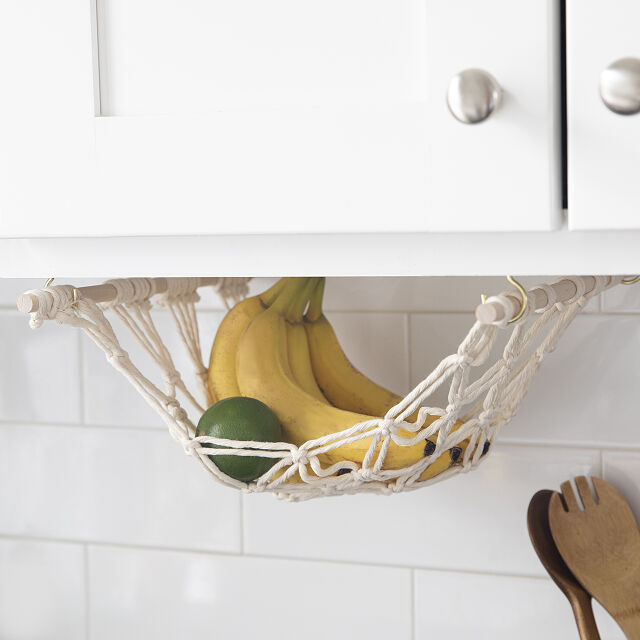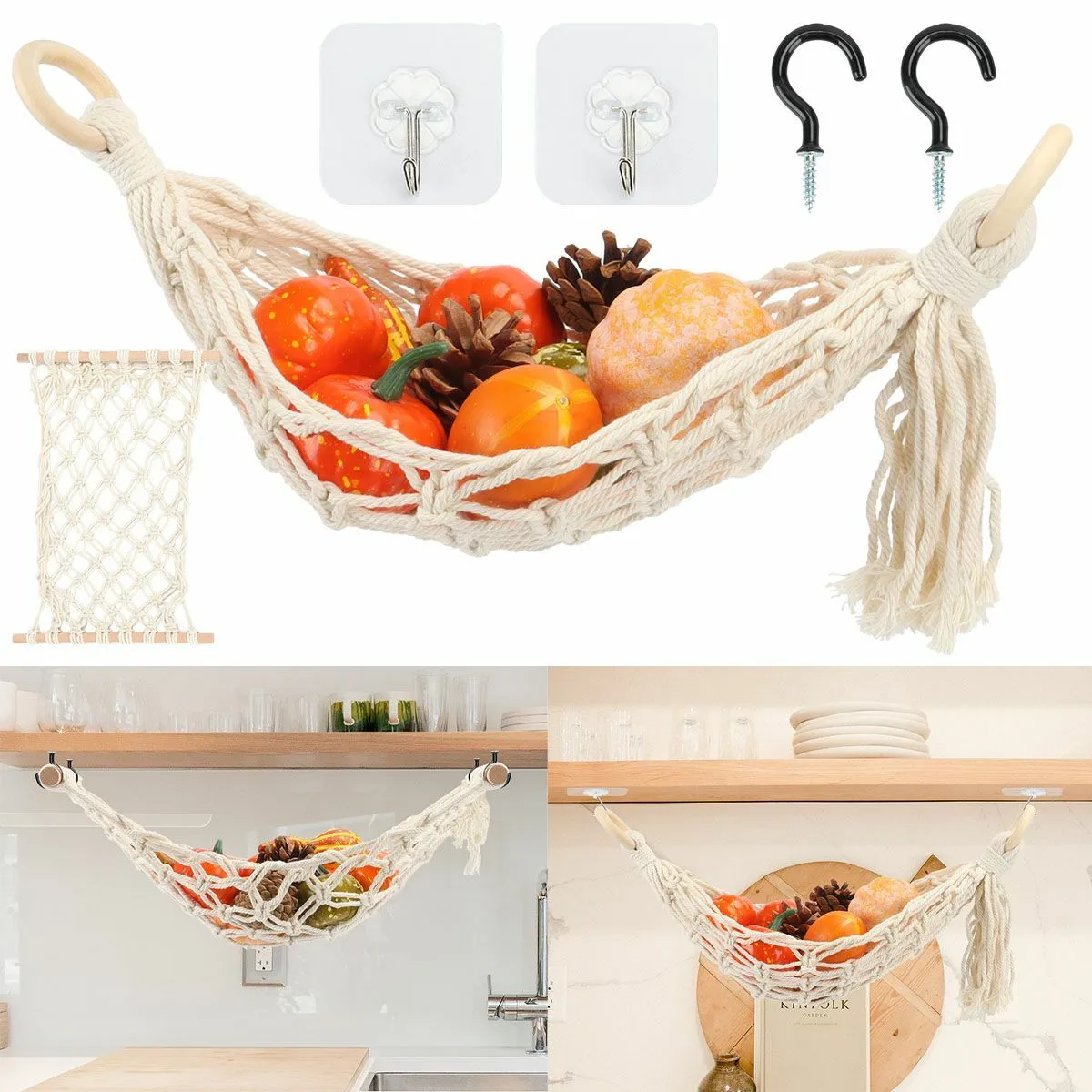Introduction: The Art of Macrame
Macrame, the art of creating intricate patterns and designs using knotting techniques, has experienced a resurgence in popularity in recent years. From plant hangers to wall hangings, macrame creations add a touch of bohemian charm and handmade elegance to any space. In this article, we’ll explore the process of crafting a macrame fruit hammock—a stylish and functional addition to your kitchen that helps keep fruits organized and easily accessible.

The Beauty of Macrame Fruit Hammocks
Macrame fruit hammocks offer a creative and eco-friendly solution for storing fruits in the kitchen. Here’s why they’ve become a favorite among DIY enthusiasts and home decor aficionados:
Space-Saving Design: Macrame fruit hammocks hang from the ceiling or a wall-mounted hook, freeing up valuable countertop and storage space in the kitchen. Their suspended design allows fruits to ripen evenly and prevents bruising or damage.
Handmade Aesthetic: Each macrame fruit hammock is a unique work of art, handcrafted with care and attention to detail. The intricate knotting patterns and natural materials add texture and visual interest to the kitchen, creating a focal point that’s both functional and decorative.
Sustainable Solution: By opting for a macrame fruit hammock instead of plastic or metal fruit baskets, you’re choosing a more sustainable and eco-friendly storage option. Macrame is typically made from natural fibers such as cotton or jute, which are biodegradable and renewable.

Getting Started with Macrame
Crafting a macrame fruit hammock may seem daunting at first, but with patience and practice, you can create a beautiful and functional piece for your kitchen. Here’s what you’ll need to get started:
Materials:
- Cotton or jute macrame cord
- Wooden dowel or metal ring for hanging
- Scissors
- Measuring tape
- S-hook or ceiling hook (if hanging from the ceiling)
- Assorted fruits for testing the size and strength of the hammock
Instructions:
- Prepare the Macrame Cord: Cut several lengths of macrame cord to your desired length, ensuring that each piece is long enough to accommodate the size of your fruit hammock. You’ll need four longer pieces for the main body of the hammock and several shorter pieces for the fringe.
- Attach the Cord to the Dowel: Fold each of the longer pieces of cord in half and loop them over the wooden dowel or metal ring, securing them with a basic lark’s head knot. Space the cords evenly along the length of the dowel to create the main body of the hammock.
- Create the Netting: Using the four longer pieces of cord, begin creating the netting for the hammock using a series of square knots or half-square knots. Alternate between rows of knots to create a diamond or grid pattern, leaving enough space between the knots to accommodate the size of the fruits.
- Add Fringe Detail: Once you’ve reached the desired length for the main body of the hammock, trim the ends of the cords to create a uniform fringe. You can leave the fringe as is or add additional embellishments such as beads or tassels for extra flair.
- Hang and Test: Once your macrame fruit hammock is complete, hang it from the ceiling using an S-hook or ceiling hook, or attach it to a wall-mounted hook. Test the strength and stability of the hammock by placing a few fruits inside and adjusting as needed.

Tips for Success
- Start with a small practice project, such as a simple plant hanger or wall hanging, to familiarize yourself with basic macrame knots and techniques before tackling a larger project like a fruit hammock.
- Choose high-quality macrame cord in a thickness and color that complements your kitchen decor. Avoid cords that are too thin or flimsy, as they may not provide enough support for the weight of the fruits.
- Take your time and work slowly and deliberately, especially when learning new knots or patterns. Practice consistency in your tension and spacing to ensure a uniform and professional-looking result.

Incorporating Your Macrame Fruit Hammock into Your Kitchen
Once your macrame fruit hammock is complete, it’s time to hang it in your kitchen and put it to use. Here are some creative ways to incorporate your new creation into your culinary space:
- Hang the fruit hammock from the ceiling above the kitchen island or breakfast bar for easy access to fresh fruits while cooking or preparing meals.
- Attach the hammock to a wall-mounted hook near the sink or prep area to keep fruits within arm’s reach for snacking or adding to recipes.
- Coordinate the color of the macrame cord with your kitchen decor and accessories for a cohesive and stylish look that enhances the overall aesthetic of the space.

Exploring Macrame Patterns and Variations
Once you’ve mastered the basic techniques of macrame, there are countless patterns and variations to explore to customize your fruit hammock to suit your personal style and preferences. Here are a few ideas to spark your creativity:
- Diamond Pattern: Create a classic diamond pattern for your fruit hammock by alternating diagonal rows of square knots. This pattern creates a visually appealing texture and provides ample support for holding fruits of various sizes.
- Feather Detail: Add a bohemian touch to your macrame fruit hammock by incorporating feather-shaped knots into the design. These decorative accents can be interspersed throughout the netting or used to create a fringe along the bottom edge of the hammock.
- Colorful Accents: Experiment with adding pops of color to your fruit hammock by incorporating brightly colored cords or yarns into the design. You can create stripes, chevron patterns, or other geometric designs to add visual interest and personality to your creation.
- Bead Embellishments: Enhance the beauty of your macrame fruit hammock by adding beads or wooden dowels to the design. Beads can be incorporated into the netting or used to create decorative accents along the fringe, while wooden dowels can add structure and stability to the hammock.
Conclusion: Crafting Functional Art
In conclusion, crafting a macrame fruit hammock is a creative and rewarding DIY project that adds both beauty and functionality to your kitchen. By using natural materials and traditional knotting techniques, you can create a unique and eco-friendly storage solution that keeps fruits organized and easily accessible while adding a touch of handmade charm to your culinary space.
So gather your materials, practice your knots, and let your creativity flow as you embark on the journey of crafting your own macrame fruit hammock. Whether you’re a seasoned macrame artist or a beginner looking for a new challenge, this project is sure to delight and inspire as you create functional art for your home.
